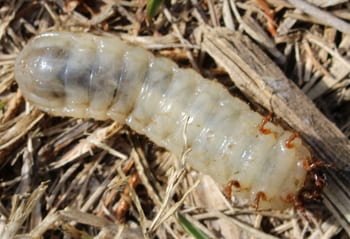–by Raymond Cloyd — Horticultural Entomologist
Green June beetle, Cotinis nitida, adults are flying around in massive numbers over both managed and unmanaged grassy areas. Green June beetle adults are erratic flyers and occasionally bump into people and objects. Adults are 3/4 to 1.0 inch long, velvety-green, with yellow-orange margins extend lengthwise on the front wings (Figure 1). The underside of the body is shiny and metallic green or gold. Adults fly around for several weeks from July through August. Green June beetle adults are sometimes mistaken for Japanese beetle, Popilla japonica, adults; however, they really do not look alike.

Figure 1. Green June Beetle Adult (Raymond Cloyd, KSU)
Green June beetle has a one-year life cycle, overwintering as a mature larva or grub in the soil. Adults typically emerge from late-June through early-July and are active during the day, resting at night on plants, in thatch, or in compost. Adults produce a sound when flying that is similar to bumble bees. Adults feed on ripening fruits and corn tassels, and may feed on the leaves of oak and maple trees. Male green June beetles swarm in the morning, flying to-and-fro just above managed and/or unmanaged grassy areas where females are located. The females emit an odor or pheromone that attracts the males. Clusters of beetles may be seen on the soil surface or in grassy areas with several males attempting to mate with a single female. After mating, females lay clusters of 10 to 30 eggs in moist soil with a high organic matter content. The larvae emerge (eclose) from eggs in approximately two weeks and feed near the soil surface. Larvae are 3/8 of an inch (early instars) to 1-1/2 (later instars) long and have the distinct characteristic of crawling on their back (Figure 2). Larvae primarily feed on organic matter in thatch or grass-clippings.

Figure 2. Green June Beetle Larva Crawling On Back (Raymond Cloyd, KSU)
For more information on how to manage green June beetle adults and larvae refer to the following extension publication:
Green June Beetle: Insect Pest of Turfgrass (MF3600 March 2022)